Y-12 Blog
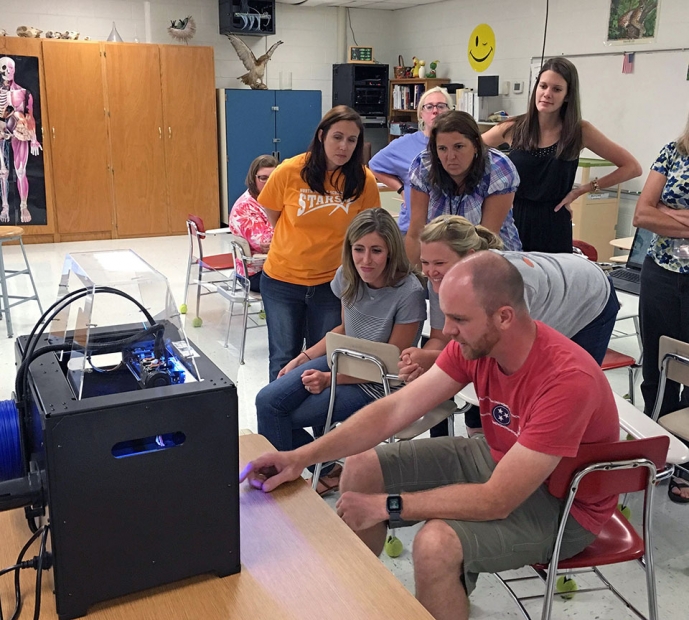 Ben Green engages with North Middle School teachers helping equip them with emerging technologies in the classroom.
Ben Green engages with North Middle School teachers helping equip them with emerging technologies in the classroom.
When young people are presented with a new technological device, they typically light up with excitement. It is like a toy that can be used to create, design, explore and understand things. Technology is a valuable teaching tool where learning seems more like fun than work.
Consolidated Nuclear Security’s (CNS’s) Ben Green of Technology Development and Mike Malone of Production are inspiring young people while helping equip school teachers with emerging technologies. At North Middle School in Lenoir City and Robertsville Middle School in Oak Ridge, the investment sparks students’ interest in fields vital to the mission at Y-12 National Security Complex (Y-12) and other high‑tech careers.
At North Middle, Green and Malone assembled a new 3‑D printer for the STEM (science, technology, engineering and mathematics) class and offered a tutorial on its operation to 14 STEM instructors and other teachers from the school.
Mike Malone explained, “3‑D printers provide a new medium for instruction. Anything normally drawn on a dry erase board can now be visualized with a model that students design and create themselves. Exposing students to this technology is vital because 3‑D design and printing have emerged as important tools in engineering and manufacturing. Offering training to the school teachers on this technology is a win‑win for the entire school.”
CNS is also helping with 3‑D printing at Robertsville Middle. STEM teacher Todd Livesay offers students an education extension program with a team of National Aeronautics and Space Administration (NASA¬) engineers and managers at the Marshall Space Flight Center in Huntsville, Alabama.
The students have developed conceptual ideas for a CubeSat — a small satellite launched from larger spacecraft in orbit. They presented their ideas and proposals to a team of NASA engineers and managers.
Next, students will engage in the processes of design, fabrication, assembly, launch and delivery of a fully launchable satellite that will be rocketed from Cape Canaveral. To do that, the students need a 3‑D printer, so CNS stepped in and is providing one to allow the students to manufacture their own designs for the CubeSat.
“By providing this technology and expertise to students and educators, CNS is helping facilitate STEM education, which CNS hopes, in turn, produces the next generation of employees,” said Kristin Waldschlager, Y-12 Education Outreach lead.
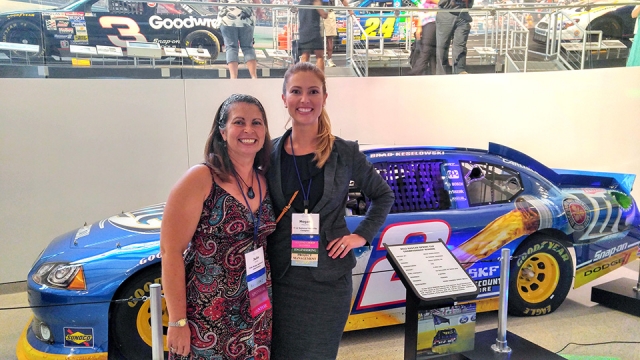 Y‑12’s Megan Houchin, right, enjoys a Women in Nuclear networking event at the NASCAR Hall of Fame in Charlotte, North Carolina. With her is Julie Ezold of the Oak Ridge National Laboratory.
Y‑12’s Megan Houchin, right, enjoys a Women in Nuclear networking event at the NASCAR Hall of Fame in Charlotte, North Carolina. With her is Julie Ezold of the Oak Ridge National Laboratory.
For two women who represented Pantex and Y‑12 at the U.S. Women in Nuclear national conference in July, the organization lives up to its acronym — WIN — by offering win‑win benefits of professional development and networking.
Megan Houchin of Y‑12 and Evalita Perez-Bobb of Pantex participated in the national 2016 conference, “U.S. WIN: Building on the Promise of Nuclear Energy,” held in Charlotte, North Carolina. Houchin, whose job title is Lean Six Sigma Black Belt, is the president of the Oak Ridge WIN chapter. Perez‑Bobb, an electrical engineer who joined Pantex a year ago, is nearly as new as the recently formed Amarillo Pantex WIN Chapter, which is about eight months old.
U.S. WIN includes chapters from across the country, comprised of 8,000 women (and men) who work in nuclear and radiation‑related fields. The national organization is affiliated with WIN‑Global, an international organization in 100 countries.
“We do a lot of professional development. We call it womentoring,” Houchin said. “Most people think WIN is for nuclear engineers, but it’s not. It’s for anyone in the nuclear industry — which is everyone at Consolidated Nuclear Security.”
After joining Pantex about a year ago as an electrical engineer, Perez‑Bobb wondered if the organization offered peer networking like she experienced serving in the Navy. She was glad to hear that Pantex employees were establishing a WIN chapter.
Perez‑Bobb attended the conference as a last‑minute substitute and wasn’t sure what to expect. Walking into a panel discussion, she immediately recognized a familiar face and a connection to her naval service. Retired U.S. Navy Admiral Robert Willard, now president and CEO of the Institute of Nuclear Power Operations, was commanding officer of the USS Abraham Lincoln when she served on the aircraft carrier.
She said it was also amazing to see that two of the four panel speakers were women: Lynn Good, CEO of Duke Energy Corp., and Maria Korsnick, CEO of Nuclear Energy Institute.
“The women there were great, so inspirational. They were presidents, CEOs or top national experts in the nuclear energy field. I was grateful for being given the chance to socialize with so many women nuclear professionals in one place,” Perez-Bobb said.
Houchin had a similar experience as she chatted with a woman seated next to her at the lunch table, the president of one of the Savannah River Site operations.
Closer to home, the chapters meet monthly and often host guest speakers. Recent professional development topics include Facilitation 101 and networking. The chapters also take part in community outreach, such as Introduce a Girl to Engineering, and members speak at schools.
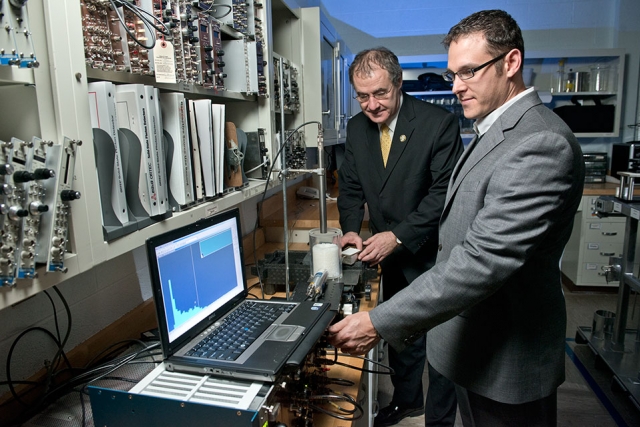 Ashley Stowe (right) partners with Arnold Burger of Fisk University and other local universities and commercial partners to advance technologies that support Y‑12’s missions.
Ashley Stowe (right) partners with Arnold Burger of Fisk University and other local universities and commercial partners to advance technologies that support Y‑12’s missions.
Ashley Stowe spent two years as Y‑12's Technology Fellow. During that time, he took a deep dive into the neutron detection work he’d begun with LISe™ (pronounced "Lisa"), the R&D 100 Award‑winning high‑efficiency thermal neutron detector. Stowe’s special assignment ultimately expanded use of the neutron detection crystal to other applications and further refined it for Y‑12’s mission work.
“New solid state radiation detectors are needed for nuclear nonproliferation and global security applications to find and secure nuclear materials and to keep the world safe,” said Stowe, the lead functional manager for sciences within Mission Engineering. LISe is sensitive and compact, opening the door to create better solutions.
“Ten years ago, radiation‑detection devices were as big as basketballs. Now, they’re significantly smaller. In fact, the LISe detector can be as small as the size of two nickels on top of each other,” Stowe said. “Compact radiation‑detection crystals offer a great advantage because they can be used much more easily in hand‑held and radiography applications. The high neutron sensitivity and small size allow us to find neutron signatures without the complications of gamma‑ray interference, which masks or confuses many detectors.”
With LISe as his launch point, Stowe explored a myriad of potential applications for the 6LiInSe2 crystal on which LISe is based. He authored 14 publications and gave 20 presentations worldwide on topics covering:
• neutron imaging in which the crystal acts like a photo plate;
• space applications, measuring neutron flux in the atmosphere;
• space experimentation to determine the feasibility of putting colonies in the atmospheres of other planets and
• astromining, looking in space for precious minerals such as helium or gold.
In his research, Stowe works closely with Vanderbilt University, Fisk University, the University of Tennessee‑Knoxville and commercial associates. “The fellowship certainly was a rich experience because it gave me the opportunity to fully explore the potential of LISe and engage local universities and commercial partners,” Stowe said. “Working together we discovered a second way LISe responds to radiation and built a prototype neutron imager with world‑class spatial resolution. That feat was recognized as a 2015 R&D 100 finalist.”
Since Stowe finished his fellowship work in late 2015, he has spearheaded the effort to update and expand Y‑12’s Technology Fellowship program. His experience will be integral in standing up the next iteration of the program.
“A key aspect of the new Consolidated Nuclear Security Fellows Program is the opportunity to develop collaborative partnerships with both universities and private industry to not only expand expertise, capabilities and research agility but also to showcase and pursue funding opportunities related to the development of the technology,” said Matt Smith of Y‑12’s Technology Development and Transfer office.
Stowe, who holds a doctorate in chemistry as well as a master’s degree in business administration, has four patents and a suite of six additional patents (in process with the U.S. Patent Office) related to the LISe technology.
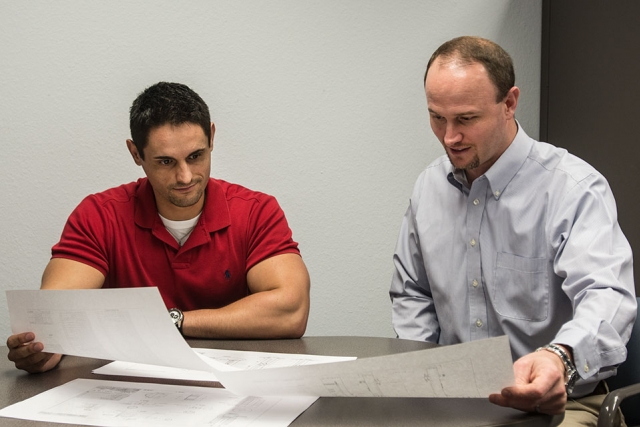 Tyler McClary (left) shares with Colby Yeary about participating in the WIP.
Tyler McClary (left) shares with Colby Yeary about participating in the WIP.
Consolidated Nuclear Security (CNS) once again has two employees participating in the Sandia National Laboratories Weapon Intern Program (WIP): Tyler McClary, Mission Engineering, and Brandon Pehrson, Y‑12 Operations. This highly sought-after internship teaches the technical details of weapon systems and provides site interactions that provide a comprehensive picture of the Nuclear Security Enterprise. Following that education, the interns work on a project with enterprise and personal value.
Both are looking forward to being a member of the WIP Class of 2017. “I hope to use the knowledge I gain to better serve the needs of Pantex,” said McClary, who has been a Pantexan for almost five years and is a lead design engineer in Tooling & Tester Design.
Pehrson, a production specialist and Y‑12 employee for 11 years, said, “I want to learn more about the weapons parts and material function so I can understand impacts of changes. I also want to become an expert in the weapons field.”
Colby Yeary and Eva Irwin of Program Integration, the CNS contacts for the program, realize there are many advantages for having Pantex and Y‑12 representatives participate.
Yeary said, “Our representatives provide a perspective from two key production agencies in the Nuclear Security Enterprise. Tyler and Brandon’s perspectives, and those of past participants, offer production agency considerations that can be overlooked in important nuclear weapon product realization activities.”
There are many benefits to the rigorous program. The first six months includes classroom work with site visits and research assignments. During the final five months, participants are embedded in various organizations across Sandia to work on specific projects.
“The interns are considered high potential and are able to develop and learn about the enterprise in an accelerated manner,” Yeary said. “It took me the better part of a decade to get the exposure and knowledge they will receive in less than a year.”
HaliAnne Crawford and Aaron Lee, the CNS representatives in the WIP Class of 2016B, offered advice to McClary and Pehrson. (During 2016, WIP had two classes.)
“No matter how daunting the next 11 months seem,” Lee said, “just jump in with both feet first as soon as possible. You have a limited time to learn as much as you can about a topic that is truly vast. Don’t waste a moment of the next 11 months because it will fly by.”
Crawford echoed Lee’s sentiment. “My advice is to get involved with the program, both inside and outside the classroom. Don’t be a passive participant. You will be learning from some of the greatest minds in our industry; ask questions and don’t be afraid to think outside the box.
“You will find that your classmates are some of the most brilliant individuals you will ever have the pleasure of working with,” Crawford said. “Get to know them, learn from their experiences and leverage their knowledge and abilities whenever possible. This year will be one of the best of your life. Enjoy every single second of it.”
Lee agreed: “Listen to your classmates. They will have just as much to teach you as the instructors do. Members of my class represented almost every other site within the NSE as well as NNSA and the military. They had knowledge and perspectives on certain topics that were completely different from my own due to their own different experiences. Everyone brought unique experiences to the program and had a lot of knowledge to share with the class.”
After the internship, WIP participants return to their respective sites to continue their leadership journeys. Yeary said, “The WIP prepares today’s workforce as tomorrow’s leaders by rapidly providing a holistic, yet reasonably detailed view of the nuclear weapons business. The program helps candidates connect dots to see the ‘big picture’ — an important attribute of senior leadership.”
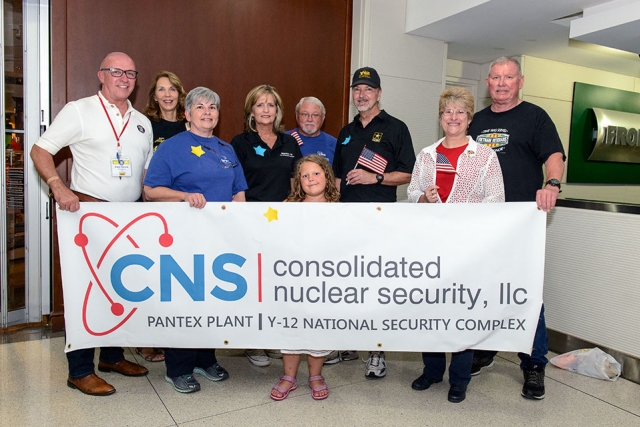 Vietnam veteran Ralph Adcox (far right) is happy to see his fellow veterans get a chance to have closure.
Vietnam veteran Ralph Adcox (far right) is happy to see his fellow veterans get a chance to have closure.
It was a good night when 73 year old Daniel Campbell finally got a solid night’s rest. For years, his sleep was interrupted by images nearly half a century old — images of death and horror in Vietnam.
“I lost my best friend in Vietnam,” Campbell said. “And I was wounded, too. For years afterward, I couldn’t sleep because I kept seeing those images. They were terrible.”
Now, Campbell said, things have changed, and they changed because of a trip he took with fellow Vietnam veterans on HonorAir Knoxville. HonorAir has flown more than 2800 East Tennessee veterans, at no cost to them, to Washington, D.C., to see the memorials built to honor their sacrifices.
“I was able to find my friend on the Vietnam War Memorial wall,” he said. He traced his friend’s name to paper and now has that keepsake. He also has another new memory. One that he says brought closure to his Vietnam experience.
“The reception at McGhee Tyson Airport,” said Campbell. “It was the most amazing thing I’ve ever witnessed in my life. It brought tears to my eyes and closure to my heart to see all those people waving American flags and thanking me for my service.”
Among those in the crowd was first timer Ralph Adcox of Safety & Industrial Hygiene. Adcox was with other Y-12 workers who regularly attend these homecomings.
Adcox has extra motivation to be there. He is a former Vietnam veteran and recalls the political turmoil and protests over the war in the 1960s.
“As a veteran, I felt it was important that fellow Vietnam vets get the long deserved ‘welcome home’ they did not get upon returning from their deployment,” said Adcox.
The trip and reception home was emotional for Campbell, and Adcox said it was emotional for him.
“Some of us enlisted, and some were drafted. Regardless, all of us took an oath and served the call of our country to the best of our ability,” Adcox said. “Being in a hostile zone requires the respect and support for our fellow soldier, sailor, airman, marine, and coast guardsman to survive. All those branches of the military were represented in the welcome home celebration, and I am proud to have taken part.”
HonorAir Knoxville was one of 30 non profit organizations that received a Y-12 Community Investment Fund grant this year.
